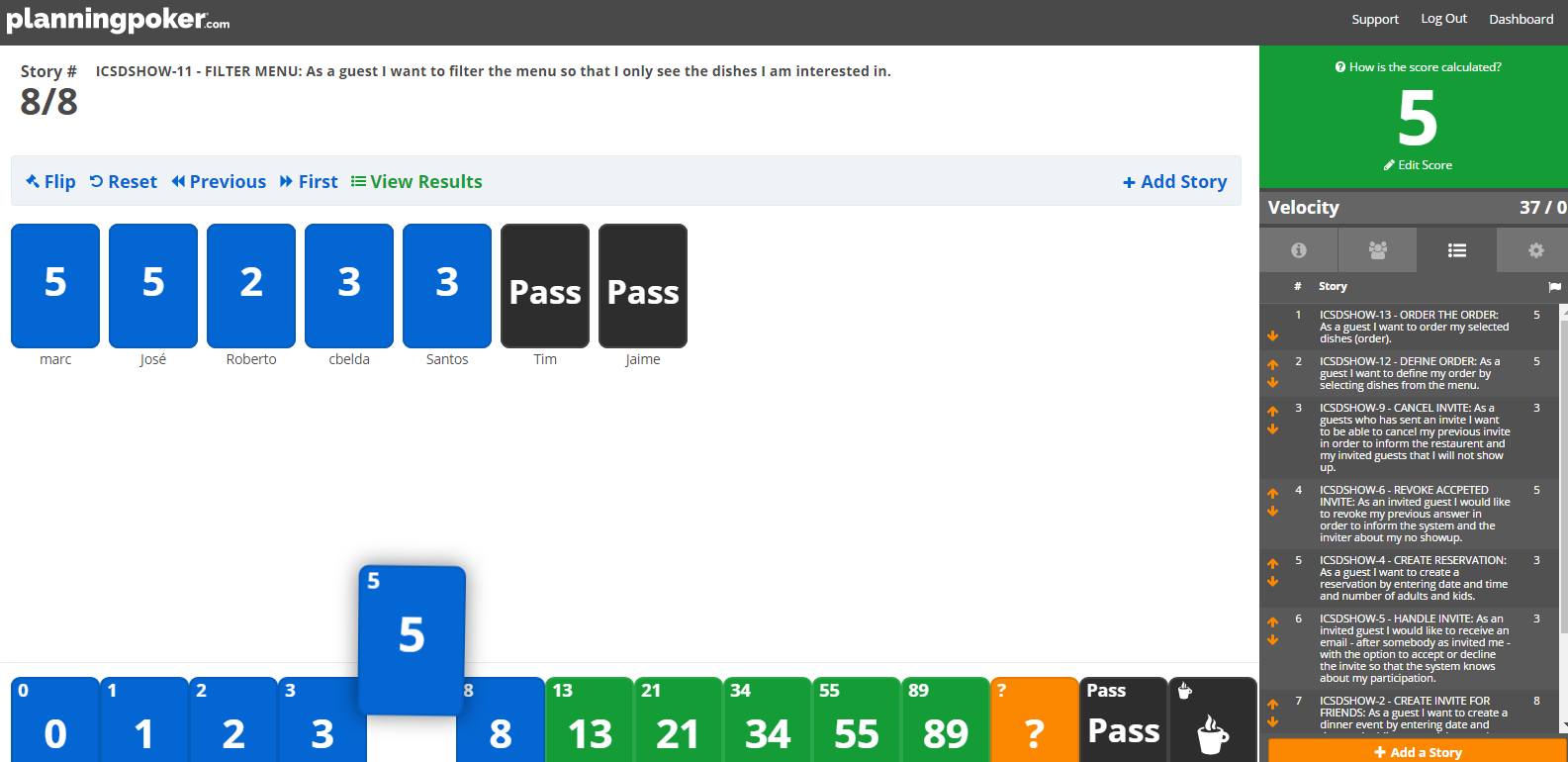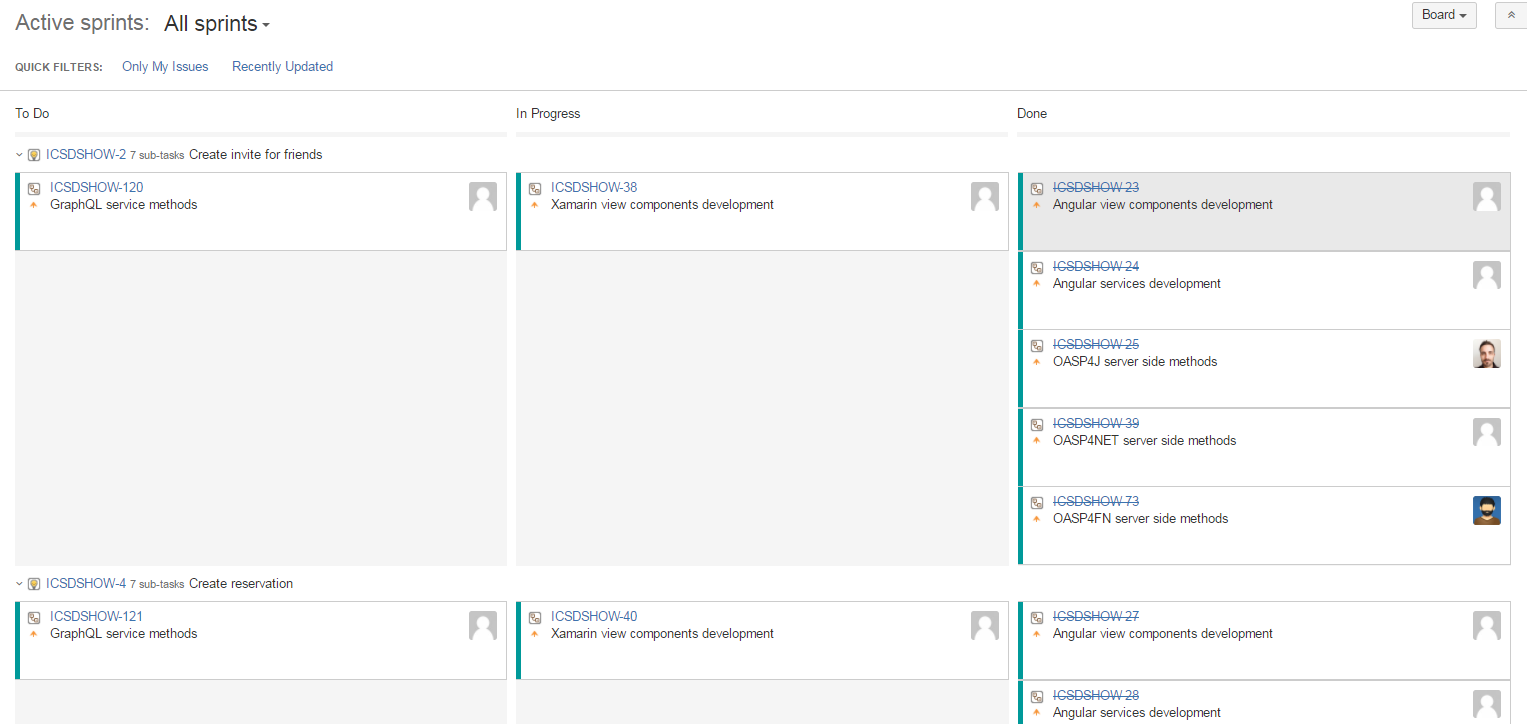-
Notifications
You must be signed in to change notification settings - Fork 126
agile
The team working on the development of the My Thai Star app and the documentation beside the technical development works distributed in various locations across Germany, the Netherlands, Spain and Poland. For the communication part the team uses the two channels Skype and Mail and for the documentation part the team makes usage mainly of GitHub and JIRA.
Within the My Thai Star project we decided on having one hour Sprint Planning meetings for a four-week Sprints. This decision is based on the fact that this project is not the main project of the team members. As the backlog refinement is done during the Sprint Planning we make usage of the planningpoker.com tool for the estimation of the tasks.
During the Sprint Planning meeting the team receives support from Devon colleagues outside the development. This feedback helps the team to focus on important functionalities and task by keeping the eyes on the overall aim which is to have a working application by the end of June 2017.
The Sprint Review meetings are time boxed to one hour for the four week Sprint. Within the Sprint Review meeting the team plans to do a retrospective of the finished Sprint. As well as it is done during the Sprint Planning the team receives support from Devon colleagues.
For this project the team aligned on not having a specific Sprint Retrospective meeting. The team is going to have a retrospective of a finished Sprint during the Sprint Review.
The team aligned on having two weekly Stand-up meetings instead of a Daily Stand-up meeting. In comparison with the time boxed length of 15mins described in the CAF for this project the team extended the Stand-up meeting to 30mins. The content of the meetings remains the same.
For the My Thai Stair project the team decided on using the JIRA agile documentation which is one of the widely used agile tools. JIRA is equipped with several of useful tools regarding the agile software development (e.g. Scrum-Board). One of the big advantages of JIRA are the extensive configuration and possibilities to personalize.
With having a list of the Epics and User Stories for the My Thai Star development in GitHub, the team transferred the User Stories into the JIRA backlog as it is shown in the screenshot below. All User Stories are labeled colorfully with the related Epic which shapes the backlog in clearly manner.
We decided on working with Sub-task as a single user story comprised a number of single and separated tasks. Another benefit of working with sub-task is that every single sub-task can be assigned to a single team member whereas a user story can only be assigned to one team member. By picking single sub-task the whole process of a user story is better organized.
In parallel to the Diary Ideation we use this Agile Diary to document our Scrum events. The target of this diary is to describe the differences to the Scrum methodology as well as specific characteristics of the project. We also document the process on how we approach the Scrum methodology over the length of the project.
Within the Sprint 1 Planning we used planning poker.com for the estimation of the user stories. The estimation process usually is part of the backlog refinement meeting. Regarding the project circumstances we decided to estimate the user stories during the Sprint Planning. Starting the estimation process we noticed that we had to align our interpretation of the estimation effort as these story points are not equivalent to a certain time interval. The story points are relative values to compare the effort of the user stories. With this in mind we proceeded with the estimation of the user stories. We decided to start Sprint 1 with the following user stories and the total amount of 37 story points:
• ICSDSHOW-2 Create invite for friends (8 Story Points)
• ICSDSHOW-4 Create reservation (3)
• ICSDSHOW-5 Handle invite (3)
• ICSDSHOW-6 Revoke accepted invite (5)
• ICSDSHOW-9 Cancel invite (3)
• ICSDSHOW-11 Filter menu (5)
• ICSDSHOW-12 Define order (5)
• ICSDSHOW-13 Order the order (5)
As the Sprint Planning is time boxed to one hour we managed to hold this meeting within this time window.
During the Sprint 1 Review we had a discussion about the data model proposal. For the discussion we extended this particular Review meeting to 90min. As this discussion took almost 2/3 of the Review meeting we only had a short time left for our review of Sprint 1. For the following scrum events we decided to focus on the primary target of these events and have discussions needed for alignments in separate meetings.
Regarding the topic of splitting user stories we had the example of a certain user story which included a functionality of a twitter integration (ICSDSHOW-17 User Profile and Twitter integration). As the twitter functionality could not have been implemented at this early point of time we thought about cutting the user story into two user stories. We aligned on mocking the twitter functionality until the dependencies are developed in order to test the components. As this user story is estimated with 13 story points it is a good example for the question whether to cut a user story into multiple user stories or not.
Unfortunately not all user stories of Sprint 1 could have been completed. Due this situation we discussed on whether pushing all unfinished user stories into the status done or moving them to Sprint 2. We aligned on transferring the unfinished user stories into the next Sprint. During the Sprint 1 the team underestimated that a lot of holidays crossed the Sprint 1 goals. As taking holidays and absences of team members into consideration is part of a Sprint Planning we have a learning effect on setting a Sprint Scope.
As we aligned during the Sprint 1 Review on transferring unfinished user stories into Sprint 2 the focus for Sprint 2 was on finishing these transferred user stories. During our discussion on how many user stories we could work on in Sprint 2 we needed to remind ourselves that the overall target is to develop an example application for the devonfw. Considering this we aligned on a clear target for Sprint 2: To focus on finishing User Stories as we need to aim for a practicable and realizable solution. Everybody aligned on the aim of having a working application at the end of Sprint 2. For the estimation process of user stories we make again usage of planningpoker.com as the team prefers this “easy-to-use” tool. During our second estimation process we had the situation in which the estimated story points differs strongly from one team member to another. In this case the team members shortly explains how the understood and interpreted the user story. It turned out that team members misinterpreted the user stories. With having this discussion all team members got the same understanding of the specific functionality and scope of a user story. After the alignment the team members adjusted their estimations. Beside this need for discussion the team estimated most of the user stories with very similar story points. This fact shows the increase within the effort estimation for each team member in comparison to Sprint 1 planning. Over the short time of two Sprint planning the team received a better understanding and feeling for the estimation with story points.
As our Sprint 1 Review four weeks ago was not completely structured like a Sprint Review meeting we focused on the actual intention of a Sprint Review meeting during Sprint 2 Review. This means we demonstrated the completed and implemented functionalities with screen sharing and the product owner accepted the completed tasks.
Within the User Story ICSDSHOW-22 “See all orders/reservations” the functionality “filtering the list by date” could have not been implemented during Sprint 2. The team was unsure on how to proceed with this task. One team member added that especially in regards of having a coherent release, implementing less but working functionalities is much better than implementing more but not working functionalities. For this the team reminded itself focusing on completing functionalities and not working straight to a working application.
-
-
Technical design
-
Data model
-
Server Side
-
Client Side
-
-
Security
-
Testing
-
Server Side
-
Client Side
-
End to end
-
-
UI design
-
CI/CD


